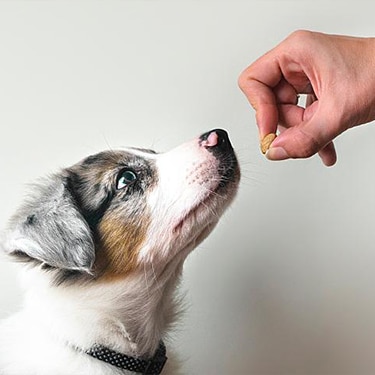
-
Find the right food for your petTake this quiz to see which food may be the best for your furry friend.Find the right food for your petTake this quiz to see which food may be the best for your furry friend.Featured products
 Adult Chicken & Barley Recipe Dog Food
Adult Chicken & Barley Recipe Dog FoodSupports lean muscle and beautiful coat for adult dogs
Shop Now Hill's Science Diet Adult Chicken & Beef Entrée Dog Food
Hill's Science Diet Adult Chicken & Beef Entrée Dog FoodChicken & Beef Entrée in a delicious loaf with complete & balanced nutrition to help keep adult dogs active and healthy
Shop Now Adult Large Breed Chicken & Barley Recipe Dog Food
Adult Large Breed Chicken & Barley Recipe Dog FoodSupports healthy joints, lean muscle, and beautiful coat for large breed dogs
Shop NowFeatured products Adult Chicken Recipe Cat Food
Adult Chicken Recipe Cat FoodSupports lean muscle and beautiful fur for adult cats
Shop Now Senior Vitality Adult 7+ Tuna & Vegetables Stew
Senior Vitality Adult 7+ Tuna & Vegetables StewImproves Everyday Ability to Get Up & Go
Shop Now Adult Turkey & Liver Entrée Cat Food
Adult Turkey & Liver Entrée Cat FoodPrecisely balanced nutrition with the delicious taste of minced turkey & liver to help fuel the energy needs of cats during the prime of their life
Shop Now -
Dog
- Dog Tips & Articles
-
Health Category
- Weight
- Food & Environmental Sensitivities
- Urinary
- Digestive
- Joint
- Kidney
-
Life Stage
- Puppy Nutrition
- Adult Nutrition
- Senior Nutrition
Cat- Cat Tips & Articles
-
Health Category
- Weight
- Skin & Food Sensitivities
- Urinary
- Digestive
- Kidney
-
Life Stage
- Kitten Nutrition
- Adult Nutrition
Featured articles How to Properly Mix Wet & Dry Pet Foods
How to Properly Mix Wet & Dry Pet FoodsAn Orange cat eating from a bowl filled with mixed food
Read More What Is Littermate Syndrome? Pet Adoption Guide
What Is Littermate Syndrome? Pet Adoption GuideLearn more about littermate syndrome in dogs and cats and how to successfully navigate adoption and early socialization processes.
Read More The Science Behind Our Love for Pets
The Science Behind Our Love for PetsLearn the scientific reasons why we have such strong connections with our pets, and what science says about the love between humans and our furry friends.
Read More -


Like people, dogs often experience failing eyesight as they get older—and need a "seeing eye" just as you would. Caring for a dog who is losing his vision (or who's already gone blind) can offer a special set of challenges for the rest of the family. But a loss of eyesight certainly doesn't mean a poor quality of life, especially for pet parents who are willing to adjust how they care for their impaired canine.
Common Causes
Dogs can go blind for a number of reasons, from disease to old age. Some of the most common reasons for blindness in dogs are cataracts, glaucoma, progressive retinal atrophy, and suddenly acquired retinal degeneration (also known as SARDS).
Certain breeds and sexes are also more susceptible to blindness. Middle-aged female dogs, for instance, are especially prone to SARDS, which causes blindness quite suddenly. Dachshunds, miniature schnauzers, and mutts are at higher-than-average risk for the disease as well, according to research reported on by PetMD. Cataracts, meanwhile, are more common in miniature poodles, cocker spaniels, miniature schnauzers, golden retrievers, Boston terriers, and Siberian huskies.
Beta Carotene
Good nutrition is vital to your dog's health and can help keep his vision healthy in some cases, although SARDS and similar vision-impairing conditions have no known treatment or approach to prevention.
But, beta carotene can help a dog's vision. According to Pet360, several foods that are healthy for both of you, such as carrots and cantelope, are known to strengthen a dog's vision and reduce the chances of cataracts. Look for dog food that lists beta carotene in its ingredients — Hill's® Science Diet®, for example.
Necessary veterinary care will vary depending on what's causing your dog's blindness. Along with beta carotene, your vet might suggest seeing a veterinary ophthalmologist, which may be more expensive than routine care. When searching for this specialist, a good place to start is an online directory kept by your country's veterinary ophthalmologist professional organization, such as American College of Veterinary Ophthalmologist (ACVO).


Tasty Tips
Living with a Blind Dog
Many volunteer organizations are actually dedicated to helping blind and visually impaired dogs by adopting them from various shelters. If you have a blind or visually impaired dog, you can reach out to these volunteer organizations for advice. Here are some helpful tips to get you started:
- Put tags or bells that jingle or make noise on other animals in the house — and consider wearing one yourself — so that your blind dog knows where his companion is.
- Teach your dog commands such as "watch," as observed by the nonprofit Best Friends, to make him aware he's approaching a hindrance. Consider "step" as well, to teach him when a stair is in front of him.
- Get down on your dog's level to look for things in your home that could harm him. Sharp table corners, for instance, could harm your dog if he approaches too quickly.
- Help put together a routine for him; this could include the trip from his bed to his food, the back door, and his favorite napping spot. Keep these pathways void of any obstacles to make it easier for him to get around. When taking him outside, you might need to keep him on a leash to guide him to his favorite spots to do his business. After time, his other senses will strengthen and help him be able to do this routine behavior on his own.
- Help him stay active. Just because your dog is visually-impaired doesn't mean he can't have fun and play. Much like a seeing-eye dog would do for a visually impaired person, you can help guide your dog along with a leash. Make sure to keep the leash short so you can better direct him where to go. It's also nice to let him sniff around and take in his surroundings through smell. It's a small gesture, but one he'll be sure to appreciate. You can also help him play. Find an open, safe area for him to be able to run around in like a backyard and play fetch with dog toys that make a noise. Through his sense of smell and hearing, he will eventually be able to track down the ball, and as you call to him to bring it back he'll use those same senses to come back to you.
There's no doubt that the care of blindness in dogs will take some special effort. But with love and time, both of you can adjust to this natural condition. Just because your dog cannot see as he used to, doesn't mean his quality of life has to suffer. Continue to show him the same love and affection that you always have and he will return the favor.


Kara Murphy is a freelance writer and pet parent who lives in Erie, Pa. She has a goldendoodle named Maddie.
Related products

Supports healthy joints, lean muscle, and beautiful coat for large breed dogs

Chicken & Barley Entrée in a delicious loaf with great taste and precisely balanced nutrition to support 5 essential building blocks for lifelong health

Chicken & Beef Entrée in a delicious loaf with complete & balanced nutrition to help keep adult dogs active and healthy

Supports lean muscle and beautiful coat for adult dogs
Related articles

Learn how to help keep your dog's immune system in tip-top shape, including nutritional immune system support for dogs and other strategies.

Discover how the field of dog science is giving us more and more insights into the inner workings of our furry best friends.

Can puppies have treats? Explore best practices for giving your puppy treats to ensure you're doing so in the healthiest way possible.

Wondering where can I buy a dog? Consider adoption and explore the pros and cons of adopting a dog from a breeder versus an animal shelter.

Put your dog on a diet without them knowing
Our low calorie formula helps you control your dog's weight. It's packed with high-quality protein for building lean muscles, and made with purposeful ingredients for a flavorful, nutritious meal. Clinically proven antioxidants, Vitamin C+E, help promote a healthy immune system.
Put your dog on a diet without them knowing
Our low calorie formula helps you control your dog's weight. It's packed with high-quality protein for building lean muscles, and made with purposeful ingredients for a flavorful, nutritious meal. Clinically proven antioxidants, Vitamin C+E, help promote a healthy immune system.

